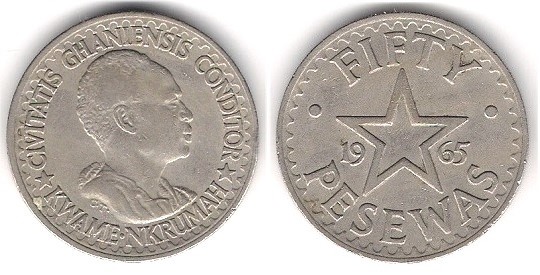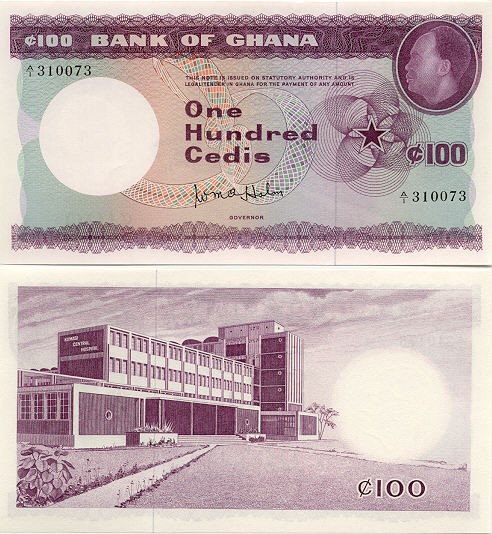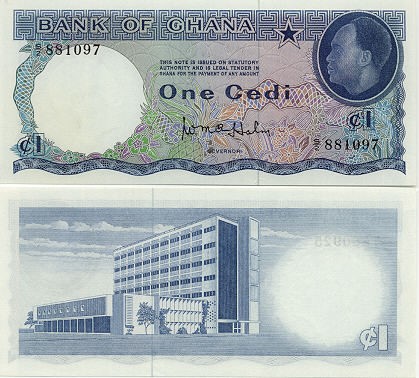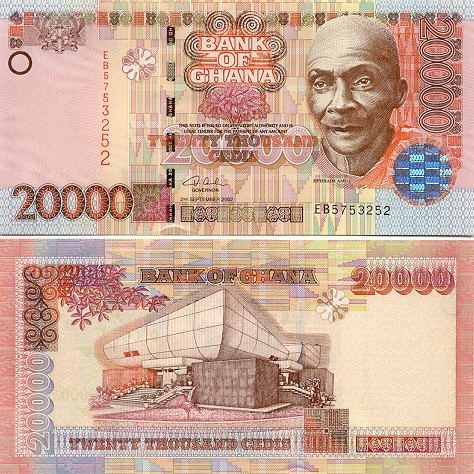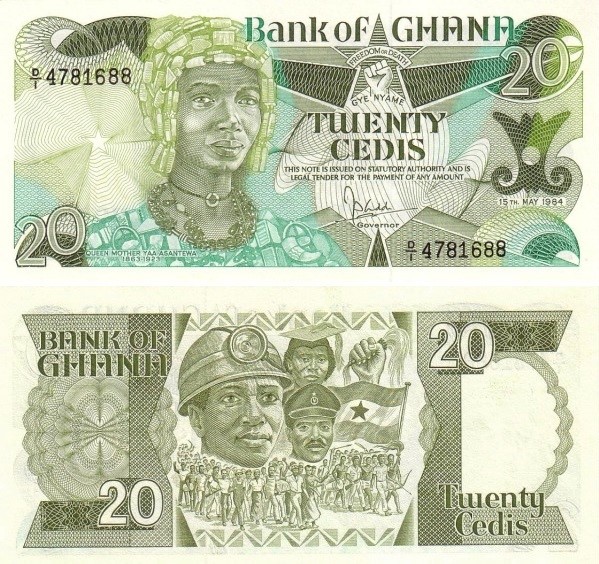Representations matter! “We live in a world that is stratified along lines of gender, race, ethnicity, class, age, disability, sexuality and location, and in which the privileges, disadvantages and exclusions associated with such categories are unevenly distributed,” as Gill (2007: 7) noted. Sometimes, the discriminations or inclusions in these strata are expressed through semiotics and discourse. What this report seeks to do is hopefully offer a critical analysis of Ghana’s currency (‘Ghanaian Cedi’) as an instrument of nationalism and assess “how images and cultural constructions [on the Ghanaian ‘cedi’] are connected to patterns of inequality, domination and oppression” (ibid).
The representations of designs and images on the Ghanaian ‘cedi’ seems to open it up for criticisms in the lines of locations, gender, ethnicity, age, class and disability. To do this, we will combine Michael Billig’s banal nationalism and other feminism theories and research findings for our discussion. For our purpose, banal nationalism refers to the periodic representations of the nation through the use of certain images on the national currency which constructs the national identity.
The currency as a medium for communicating national identity (Billig, 1995) and value is widely circulated and consumed than any other media form. First, we will introduce the country in respect of her cultural settings and the evolution of her currency and its designs. Particularly, we will show how the design of the currency has been in honour and recognition of some. We will also discuss the culture and gender representations in the media. We will conclude that the images embossed on Ghana’s legal tender are reflective of the gender representation in the leadership of the political economy of Ghana.
Literature Review
There seems to be a lean body of literature on feminist and gender in Ghana. However, “sex for grades” in Higher Education Institutions in Ghana has been a recurring theme for decades. A recent investigative journalistic work (Africa Eye, 2019) uncovered and implicated some lecturers of West African Universities, including Ghana for allegedly sexually harassing their students. According to Britwum and Anokye (2006), which found repeated occurrences of sexual harassment on campus, the menace was an inhibiting factor on women’s success and dignity through education. It is important to state, however, that this problem is shared among the rest of African countries and beyond. Several studies have investigated the problem using different terms and notions to highlight their effects.
For example, labelling the phenomenon as a ‘phallic attack’ in Nigeria Nwadigwe (2007) identified the serious risks posed to the victim’s understanding of what is taught and their general wellbeing. It is contended (Bakari and Leach, 2007) that sexual harassment is a way of preserving male power in Nigeria. Similarly, Townsley and Geist (2000) noted in their study of the US that sexual harassment is a micro-level practice connected to a macro-level patriarchal dominance. Whether in Kenya or South Africa (Omale, 2002; Simelane, 2001), Hong Kong (Chan et al, 1999) or Israel (Kaplan, 2006); all reported the thunder and silence of sexual harassment and its negative impacts on women’s academic pursuits.
For fear of victimisation and stigmatisation, this sexual corruption in institutions are rarely formally reported by their victims (Manuh et al, 2007: 138). Morley’s (2011) study in Ghana revealed male students bemoaning their female counterparts who do not even sit for exams scoring better than them. Thus, festers the opinion that women are advantaged to have a sexuality for ‘beneficial’ trade and at the mercy of affirmative actions (Jackson, 1999). Again, it is argued by Morley (2011:105) that the negative construction of women might be a response to their performances and achievements. This negative construction about women’s identities seems to transcend represented gender identities (women and men) as both tend to negatively construct some females in the same negativity (ibid).
Feminists theorists (as far back as Wollstonecraft, 1792) identified gender disparities and called for fair representation of women in all facets of life. She (ibid) pointed out that “women were human beings who should not be denied the same individual rights and privileges, including the rights to education, earnings and property ownership.” It is argued (de Beauvoir 1973: 143) that the general outlook of the world is based on the view of men “which they confuse with the absolute truth.” Thus, a woman in this constructed world of “men” is anonymous. Similarly, it is argued by Irigaray (1974: 101-103) that the phallocentric language employed in this dialectic completely denies women of fair representation in the world. This common view of the feminist theory is based on the central assumption that an identity exists which requires to be represented in social affairs. At first glance, “gender” is seen as the human features (including biological and sex-based social structures) which differentiate between masculinity and femininity, whereas “sex” refers to being male or female.
Thus, gender is culturally and socially predetermined while sex can be changed. This theory seems to reflect the cultural expressions and gender perceptions in Ghana (UNESCO, 2007). Butler (1990), however, argues that this “distinction” is a false one. To her, gender and sex are both constructed. Gender, accordingly (ibid), is defined by the repeated stylisation of the body. So, there are no stable identities that these acts “express”: the identities are actually constituted by these acts. Respectfully, whether gender is performative or imposed is a matter of philosophy. That is because gender identities, in fact, exist in discourse and semiotics and in development policies worldwide.
Finally, several scholars (James, 1977; Tsikata, 1989; Allah-Mensah, 2005; Prah, 2004; Manu, 1991) have acknowledged the essential contributions that women played in Ghana’s independence struggle which earned them praises and political appointments in the first government of post-independent Ghana. Padmore (1953) at some point even described women as the ‘backbone’ of the independence crusade. To mention a few of these women are; Hanna Kudjoe, Sophia Doku and Dr Evelyn Amarteifio who was particularly eulogised for her remarkable political activism and organizational abilities (Vietta, 1999). As Bell (1987) noted, a substantial amount of research into gender inequality or femininity in Ghana seems to be conducted by only women. For context, the next discussion focus on gender representation on Ghana’s currency.
Gender Representations and Evolution of the Ghanaian Currency ‘Cedi’
Ghana (former Gold Coast), previously under British colonial rule, is the first sub-Saharan Africa country to gain political independence in 1957. In 1958, the nation showed her first glimpse of independence by abandoning the British West African pound, which was the unit of legal tender among Her Majesty’s subjects in the West African region. The new Ghanaian pound proved insufficient show of ‘the Black man’ as ‘capable of managing [their] own affairs’, and Ghana eventually left the British Pound System to join the popular Decimal System. The word ‘cedi’ is an Akan term for cowry shells, which is suggested as a medieval currency in West Africa (Hiskett, 1966). Accordingly, the introduction of the ‘cedi’ signified a return to their roots. Despite undergoing modifications and redenomination, the Ghanaian ‘cedi’ remains
the only legal tender in the Fourth Republic of Ghana.
Historical antecedents point in the direction that the design or images on the currency are regarded as a symbol of power and recognition (Penrose, 2011) in Ghana. Between 1965 and 1967, the first ‘cedi’ (sample below) which bore the portrait of Ghana’s first President Dr Kwame Nkrumah (obverse) and the five-pointed star or other landmarks like Bank of Ghana (reverse) was used until the overthrow of the CPP government
The coup paved the way for the new military regime to phase out the images of Nkrumah from the national currency and effectively oust his authority. From 1967, the ‘new cedi’ continued as the only legal tender until 2002, when Nkrumah’s image re-appeared on the newly launched 10,000 Cedis note (below left) under the pretext of the ‘Big Six’ (recognized founding fathers of Ghana).
The ‘Big Six’ aside, the 2002 print series also featured Ephraim Amu (male composer of the national anthem) on the 20,000 Cedis note (below right).
While masculinity (both identifiable and non-identifiable) dominated in all the other denominations of the ‘cedi’ printed between 1967 and 2007, the few occasions femininity was represented were non-identifiable persons (except Nana Yaa Asantewaa from 1984-1986 on the 20 Cedis note below) much like the natural resources and landmarks that also prominently featured.
Similarly, the ‘Big Six’ featured on all denominations of the current Ghanaian ‘cedi’ notes (below) in the 2007 series, while only the 50 pesewas coin (second from bottom-left below) bore a woman (non-identifiable).
Part 1




